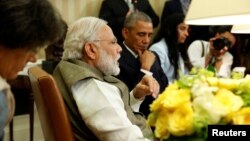Air conditioners may make you cooler, but the chemicals they use are making the planet warmer.
And that's especially a problem because air conditioner sales are booming in the developing world, where there's lots of room for the market to grow.
That is why environmental groups were happy to hear Indian Prime Minister Narendra Modi and U.S. President Barack Obama agree this week to cooperate on phasing out the worst of these chemicals.
Air conditioners commonly run on chemicals known as hydrofluorocarbons, or HFCs. Many HFCs are thousands of times more potent greenhouse gases than carbon dioxide.
The market for HFCs is booming. Demand for air conditioners is growing by 10 to 15 percent per year in hot, developing countries like India, Indonesia and Brazil, according to a Lawrence Berkeley National Laboratory report. And there's a lot of room for growth. The study noted that only about five percent of the Indian market had air conditioners in 2011.
Between their potency and their rate of growth, one study found that eliminating the most heat-trapping HFCs would reduce global warming by 0.5 degrees C.
That's an enormous figure, considering the planet has warmed about one degree C since pre-industrial times, and the Paris climate agreement aims to keep warming to 1.5 degrees.
HFCs were introduced in the 1990s to replace chlorofluorocarbons, or CFCs. Those chemicals were depleting the ozone layer of the Earth's atmosphere, letting in more ultraviolet radiation and raising the risk of skin cancer and crop damage.
Better Alternatives
"At the time, unfortunately, people were not looking necessarily looking at climate change," said Karim Amrane, a senior vice president at the Air Conditioning, Heating and Refrigeration Institute, a trade group. "We were looking at ozone depletion. And HFCs don't deplete the ozone layer. They were great."
Now diplomats are working to add the most heat-trapping HFCs to the Montreal Protocol, the treaty that phases out CFCs.
"India was one of the last biggest holdouts," said former U.S. State Department climate negotiator Andrew Light, a senior fellow at the World Resources Institute.
Light said, over two years of negotiations, India has gone from actively opposing a phaseout to offering its own proposal. But there were major differences between the Indian and U.S. proposals in timing and funding for the transition to less-damaging chemicals.
Hashing out these differences was on the agenda for this week's Obama-Modi meeting. While the joint statement released afterward included no details, it said "the two countries resolved to work to adopt" an agreement in 2016.
"What I read is, they're starting to get there," Light said, and "there's an agreement in principle that they're going to get there before the next [meeting] in October," at the annual meeting of signatories to the Montreal Protocol. That's when a proposal to phase out the most problematic HFCs could formally be introduced.
Leapfrog Next Step
Meanwhile, many major manufacturers are starting to switch coolants on their own.
"Everyone recognizes this has to happen and it's going to happen. The question is when and how," said Dave Calabrese, vice president for government affairs at air conditioner maker Daikin.
Daikin, Ingersoll Rand, Honeywell and other air conditioner manufacturers took part in last week's Clean Energy Ministerial meeting in San Francisco, a 23-nation effort to boost low-carbon technologies.
"Some businesses [are] on board, but not all businesses," said Anjali Jaiswal, India program director at the Natural Resources Defense Council.
Many Indian manufacturers are still in the process of phasing out CFCs. Encouraging them to leapfrog to less-warming HFCs will require a financial carrot and a policy stick. Updating the Montreal Protocol should do both, she adds.
"It's really important to get the agreement now before India and other big developing countries actually have this full-scale investment in the technology that uses these chemicals," Light added.







